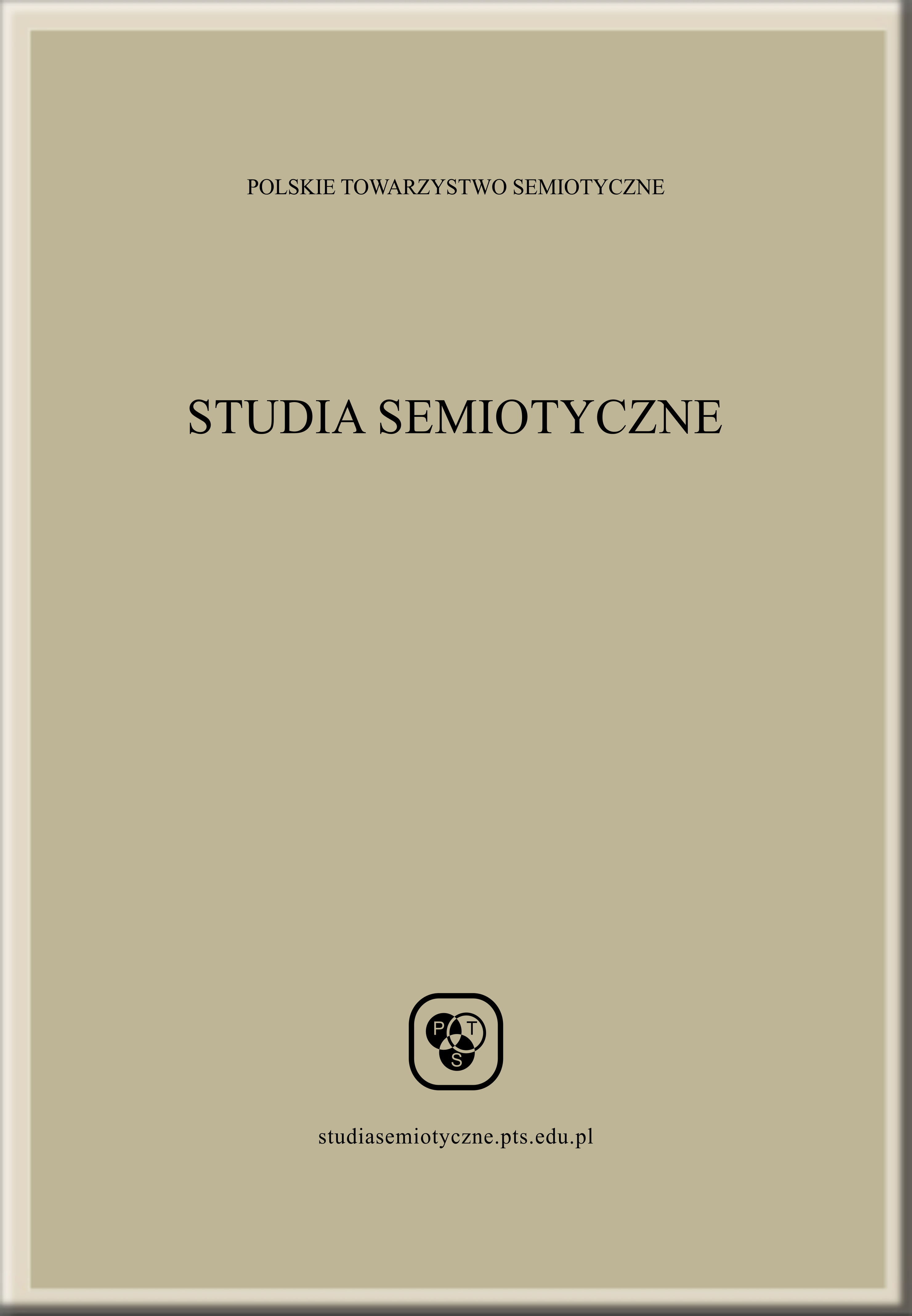Abstract
The article presents a model of the structure of the act of communicative reference from the sender's point of view. The foundation of the act of communicative reference includes two acts: the act of semantic reference to the addressee and the act of in-reading the world into the addressee (assigning him the role of the recipient). Both acts are coupled together by an act of metareference, thanks to which Quine's effect of referential indeterminacy disappears. The act of metareference is evoked by the act of assigning oneself the role of sender. This act is caused by the act of in-reading the world into the addressee. The function of the act of metareference is to "execute" the fusion of the two acts. Over the act of in-reading the world into the recipient, there is founded the act of locating him in the world in which the sender locates himself. The act of establishing communication paths binding the sender with the recipient is based on the act of locating the receiver in the world. Depending on the type of an act of locating the recipient in the world, the constituted communication paths can belong to three categories: completed and single-ray, completed and multi-ray, open and multi-ray. The type of communication path determines the type of physical bond binding the sender with the world in-read into the recipient. The act of typifying the recipient is based on the act of semantic reference. The act of typifying the recipient and the act of in-reading the world into are the foundational basis for the act of constituting communication gates in the world in-read into the recipient. The gates established by the sender determine the expected way of acknowledging the receipt of the transmission of messages sent on a specific topic and in the expected way. Thanks to all these acts, the sender establishes the recipient's typification metric, i.e., the way in which the recipient appears to the sender in the transmitting act of communicative reference.
References
Austin J. L. (1962). How to Do Things with Words, Clarendon Ptess: Oxford (wyd.pol: Jak działać slowami, w: J. L. Austin, Mowienie i poznawanie, tłum. B. Chwedeńczuk, PWN: Warszawa 1993, s.543-713).
Austin J. L. (1970). „Performative Utterances” [w:] J. L. Austin, Philosophical Papers, Oxford University Press: Oxford, s. 233-252 (wyd. pol.: Wypowiedzi performatywne, w: J. L. Austin, Mowienie i poznawanie, tłum. B. Chwedeńczuk, PWN: Warszawa 1993, s. 311-334).
Beaugrande R. A. , Dressler W. U. (1990). Wstęp do lingwistyki tekstu, (tłum. A. Szwedek), Warszawa: PWN.
Berger P. L., Luckman T. (1983). Spoleczne tworzenie rzeczywistosci, (tłum. J. Niżnik), Warszawa: Państwowy Instytut Wydawniczy.
Bianchi C. (2021). „Injustice: The Role of Uptake”, Topoi 40, 181-190.
Biłat, A. 2009. ‘Filozoficzne podstawy logiki sytuacji’, [w:] A. Biłat, red., Aporie ontologii sytuacji, Lublin: Wydawnictwo Uniwersytetu Marii Curie-Skłodowskiej, s. 95–153.
Eliade M. (2000). Traktat o historii religii, tłum. J. W. Kowalski, Wydawnictwo KR: Warszawa.
Furberg M. (1969). „Meaning and Illocutionary Force, [w:] L. T. Fann (ed.), Symposium on J. L. Austin, London , s.445-467.
Gad A. (2009). “Autyzm, intencjonalność, możliwe światy”, Ruch Filozoficzny, LXVI, 3, s. 485-494.
Haythornthwaite C. (1996). Social network analysis: An approach and technique for the study of information exchange. Library & Information Science Research 18(4), s.323-342.
Hintikka J. (1974). “Knowledge by Acquaintance – Individuation by Acquaintance”, [w:] J. Hintikka, Knowledge and the Known: Historical Perspectives in Epistemology, s. 212-233, Dordrecht: D. Reidel Publishing Company.
Hintikka J. (1975). „The Intentions of Intentionality” [w:] J. Hintikka, The Intentions of Intentionality and other New Models for Modalities, Dordrecht: D. Reidel Publishing Company, s. 192-222.
Hintikka J. (1980). “Degrees and Dimensions of Intentionality”, [w:] R. Haller, W. Grassl (red.), Language, Logic, and Philosophy. Proceedings of the Fourth International Wittgenstein Symposium 28 August to 2nd September 1979 Kirchberg am Wechsel (Austria), Vienna: Hӧlder-Pichler-Tempsky, s. 69-82.
Ingarden R. (1971). O dziele literackim (wyd. II), Państwowe Wydawnictwo Naukowe: Warszawa.
Kaczmarek J. (2009). „Ontologia sądow i stanow rzeczy w strukturach PTS, CS i U” [w:] A. Biłat, red., Aporie ontologii sytuacji, Lublin: Wydawnictwo Uniwersytetu Marii Curie-Skłodowskiej, s. 201-232.
Krysztofiak W. (1999). Problem opozycji realizmu i idealizmu epistemologicznego, Wydawnictwo Uniwersytetu Marii Curie-Skłodowskiej: Lublin.
Krysztofiak W. (2007). „Spór o ontologię sytuacji jako spór o zasadę kompozycyjności. Argument z metafory”, Filozofia Nauki, Rok XV, Nr 4(60), s. 51-70.
Krysztofiak W. (2009). „Co wyraża argument Slingshot?” [w:] A. Biłat, red., Aporie ontologii sytuacji, Lublin: Wydawnictwo Uniwersytetu Marii Curie-Skłodowskiej, s. 37-73.
Monge P. R., Contractor N. (2003). Theories of Communication Networks. Oxford University Press: New York.
Omyła, M. (1986). Zarys logiki niefregowskiej, Warszawa: PWN.
Paśniczek J. (1988). Meinongowska wersja logiki klasycznej, Uniwersytet Marii Curie-Skłodowskiej: Lublin.
Quine W.V.O. (1960). Word and Object. Cambridge MA: MIT Press [Quine W.V.O. (1999). Słowo i przedmiot. Tłum. C. Cieśliński, Warszawa: Fundacja Aletheia)]
Quine W.V.O. (1973). The Roots of Reference. Open Court, La sale, Illinois [Quine W.V.O. (2006). Korzenie ontologii. Wykłady im. Paula Carusa. Tłum. B. Stanosz, Warszawa: Fundacja Aletheia].
Russell B. (1910/11). „Knowledge by Acquaintance and Knowledge by Description”, Proceedings of the Aristotelian Society, 11, s. 108-128.
Russell B. (1914). „On the Nature of Acquaintance”, The Monist 24, s. 161-187.
Sendłak M. (2018). Spór o przedmioty nieistniejące. Współczesne interpretacje teorii przedmiotu Alexiusa Meinonga, Wydawnictwo Naukowe Semper: Warszawa.
Shannon C. E., Weaver W. (1948). The Mathematical Theory of Communication. Urbana, IL: Illinois UP. Reprint 1963.
Stein E. (1988). O zagadnieniu wczucia. Przeł. D. Gierulanka, J. F Gierula, Wydawnictwo ZNAK: Kraków.
Strawson P. F. (1980). Indywidua. Próba metafizyki opisowej. przeł. B. Chwedeńczuk, Instytut Wydawniczy PAX: Warszawa.
Suszko, R. (1968). “Ontology in the Tractatus of L.Wittgenstein”, Notre Dame Journal of Formal Logic, 9, 7–33.
Szymura J. (1982). Język, mowa o prawda w perspektywie fenomenologii lingwistycznej J. L. Austina, Zaklad Narodowy Imienia Ossolińskich, Wydawnictwo Polskiej Akademii Nauk: Wrocław-Warszawa-Krakow-Gdańsk-Łódź.
Witek M. (2012). Spór o podstawy teorii czynności mowy. Wydawnictwo Naukowe Uniwersytetu Szczecińskiego: Szczecin.
Wójtowicz, A. (2007). Znaczenie nazw a znaczenie zdań. W obronie ontologii sytuacji, Warszawa: Wydawnictwo Naukowe Semper.
Żegleń U. (1983). „Analiza semantyczna relacji występujących w ontologii Romana Ingardena”, Studia Semiotyczne, Vol. XIII, s. 35-47.


